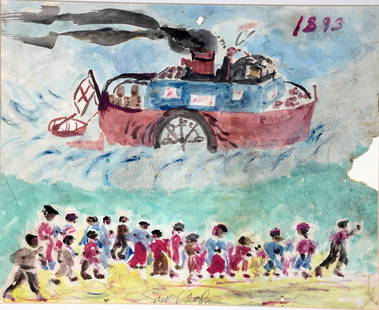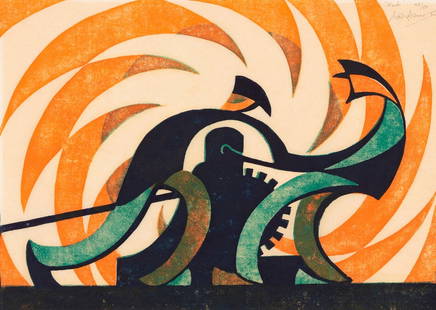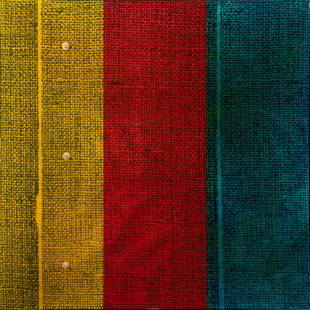
Sam Doyle. Dr. Buz Ha Lo!
Sam Doyle Sale History
View Price Results for Sam DoyleRelated Art
More Items in Art
View More












Item Details
Description
Sam Doyle. Dr. Buz Ha Lo!
c. 1983.
Signed bottom right "S.D."
Titled "Dr. Buz Ha Lo!" top.
Enamel and conch shell on repurposed metal.
Excellent environmental condition.
Painting is 24.25"w x 52"h.
Frame is 28.25"w x 54"h x 4"d.
Museum quality piece.
Literature: Illustrated in Lynne E. Spriggs, Local Heroes, Paintings and Sculpture by Sam Doyle, High Museum of Art, Atlanta, 2000, page 28.
Provenance: Purchased directly from the artist by African American writer Gloria Naylor.
1950-2016.
The Mike Dale Collection.
Est. $30,000-$40,000.
Buyer is responsible for shipping.
Thomas Samuel "Sam" Doyle, Jr. was born on March 23, 1906 near Frogmore, on St. Helena Island, South Carolina, one of nine children born to farming parents Thomas Samuel Doyle, Sr. and Sue Ladsen Doyle. Doyle's parents farmed a 15 acre parcel of land that was part of the old Wallace Plantation on St. Helena Island where his great grandparents had been enslaved. After the Civil War, the Wallace Plantation was divided up among the slaves who had worked the land. The island was the center of the region's Gullah culture, where African influences thrived in virtual isolation from the mainland. As a boy Doyle absorbed his cultural traditions through a rich oral history passed down through generations. St. Helena was only reachable by boat until 21 years after Doyle was born, at which point a bridge was built connecting downtown Beaufort to the Sea Islands. Doyle attended the Penn School, founded in 1862 by Unitarians and Quakers from Pennsylvania, where he received encouragement for his artwork and studied history.
Doyle left Penn School in the ninth grade to earn a living, and worked for nine years as a stock clerk at the Saint Helena Corner Store. For a brief period, Doyle moved to Beaufort and, from 1930 to 1950, he worked as a porter in a cotton warehouse. While in Beaufort, Doyle met his future wife, Maude Brown, with whom he had three children. In 1943, Doyle moved the family to St. Helena Island, living in a modest two-story house on family farmland. By this point, the United States had entered World War II, and Sam Doyle, always a patriot, wanted to enlist, but he was classified as "unfit"for military service because of an improperly treated childhood foot injury which left him with a lifelong limp. His wife, accustomed to city life, could not stand the rural isolation of St. Helena, and she divorced Doyle in 1949 to seek a more fulfilling life in her native New York City. Arrangements were made with relatives on the mainland so that Doyle's children could pursue higher education in other areas of the state. Perhaps to ease his disappointment at being rejected by the military, or to serve his country in his own way, Doyle took a job in the laundry at the Marine Corps Recruit Training Depot on Parris Island.
Some of Doyle's earliest pieces of art were sculptures of animals, birds, and reptiles made of roots and covered with materials such as tar, feathers, and glass, objects associated with conjuring practices. In 1944, Doyle began making paintings created with house paint on discarded metal roofing and wood panels. Doyle considered himself a historian, preserving in paint portraits of people and events important to his Gullah heritage and community. With more time to paint after retiring from his Civil Service laundry job in 1968, he became prolific, with works overflowing the yard and covering the walls of his house and studio, evolving into the St. Helena Out Door Art Gallery. Doyle spent the remainder of his life creating art and keeping the grounds at The Chapel of Ease ruins on Saint Helena Island. He is believed to have created between 500 and 700 paintings in his lifetime.
His initial audiences were his friends and neighbors on St. Helena. Doyle documented the residents of the island as well as legendary characters derived from myth and superstition. His approach was both balanced and entertaining, documenting both strengths and weaknesses and holding nothing back as he explored personal achievements (the first black doctor, barber, midwife, embalmer, postman, etc…), sexual peculiarities, mystical powers, and the unusually eccentric. Doyle was also proud of prominent blacks in American society, and he painted legends such as Joe Louis, Jackie Robinson, Ray Charles, Martin Luther King, Jr., and assorted athletes and entertainers. Abraham Lincoln is also featured prominently in a number of works.
Doyle was inevitably drawn to the region's root doctors, practitioners of folk medicine who served as the primary source of cures and remedies for most of the island's residents.In Gullah communities, root doctors were revered spiritual healers, believed to be conduits between the physical world of the living and the spiritual world of the departed. The most powerful of all the St. Helena root doctors was Dr. Buz, with references to a Dr. Buzzard dating back to 1700. Multiple Dr. Buzzards have practiced throughout succeeding generations, including one that Doyle consulted personally. According to local legend, Dr. Buz received his inspiration from the spirits via a conch shell. Doyle said that the "conch shell was his (Dr. Buzzard's) phone line. He put it to his ear, he switch his hand in the air, and then he must get an answer, 'cause he say, 'Halo, halo, halo, this is the Dr. talkin' to you.' You could hear him grumbling and talkin' to the spirit with the conch shell in his ear."
Dr. Buz is one of Doyle's most iconic images, and the Dr. Buz Ha Lo! painting offered here is a superb example. In this work, Doyle affixed an actual conch shell to Dr. Buz's ear, a three-dimensional representation of the doctor's special powers reaching out to tangibly engage the viewer. This example also depicts Dr. Buz in his dark tinted sunglasses, required wear for all root doctors, because they block others' view of his eyes and, most importantly, his thoughts.
Doyle's work was included in Black Folk Art in America, 1930–1980, a large-scale exhibition that opened in 1982 at the Corcoran Gallery of Art in Washington, DC, and later toured throughout the United States.Doyle attended the opening, his only excursion away from his home state, and fondly remembered shaking the hand of First Lady Nancy Reagan. The exhibition introduced Doyle's unique artwork to a broader and highly appreciative audience that included artists such as Jean-Michel Basquiat, who collected Doyle's work, and Ed Ruscha.Doyle's work was also featured in a one-man show, Local Heroes, Paintings and Sculpture by Sam Doyle at the High Museum of Art in Atlanta in 2000.
Prominent public collections of Doyle's work include the High Museum of Art, Atlanta, GA; the American Folk Art Museum, New York, NY; the Dallas Museum of Art, Dallas, TX; the New Orleans Museum of Art, New Orleans, LA; the South Carolina State Museum, Columbia, SC; and the Smithsonian American Art Museum, Washington, D.C., to name a few.Doyle died in Beaufort, South Carolina, on September 24, 1985.He was 79 years old.
African American writer Gloria Naylor, whose collection this painting comes from, received tremendous accolades for her first novel, The Women of Brewster Place (1982), which won a National Book Award and was adapted into a highly successful television mini-series that starred and was produced by Oprah Winfrey.
c. 1983.
Signed bottom right "S.D."
Titled "Dr. Buz Ha Lo!" top.
Enamel and conch shell on repurposed metal.
Excellent environmental condition.
Painting is 24.25"w x 52"h.
Frame is 28.25"w x 54"h x 4"d.
Museum quality piece.
Literature: Illustrated in Lynne E. Spriggs, Local Heroes, Paintings and Sculpture by Sam Doyle, High Museum of Art, Atlanta, 2000, page 28.
Provenance: Purchased directly from the artist by African American writer Gloria Naylor.
1950-2016.
The Mike Dale Collection.
Est. $30,000-$40,000.
Buyer is responsible for shipping.
Thomas Samuel "Sam" Doyle, Jr. was born on March 23, 1906 near Frogmore, on St. Helena Island, South Carolina, one of nine children born to farming parents Thomas Samuel Doyle, Sr. and Sue Ladsen Doyle. Doyle's parents farmed a 15 acre parcel of land that was part of the old Wallace Plantation on St. Helena Island where his great grandparents had been enslaved. After the Civil War, the Wallace Plantation was divided up among the slaves who had worked the land. The island was the center of the region's Gullah culture, where African influences thrived in virtual isolation from the mainland. As a boy Doyle absorbed his cultural traditions through a rich oral history passed down through generations. St. Helena was only reachable by boat until 21 years after Doyle was born, at which point a bridge was built connecting downtown Beaufort to the Sea Islands. Doyle attended the Penn School, founded in 1862 by Unitarians and Quakers from Pennsylvania, where he received encouragement for his artwork and studied history.
Doyle left Penn School in the ninth grade to earn a living, and worked for nine years as a stock clerk at the Saint Helena Corner Store. For a brief period, Doyle moved to Beaufort and, from 1930 to 1950, he worked as a porter in a cotton warehouse. While in Beaufort, Doyle met his future wife, Maude Brown, with whom he had three children. In 1943, Doyle moved the family to St. Helena Island, living in a modest two-story house on family farmland. By this point, the United States had entered World War II, and Sam Doyle, always a patriot, wanted to enlist, but he was classified as "unfit"for military service because of an improperly treated childhood foot injury which left him with a lifelong limp. His wife, accustomed to city life, could not stand the rural isolation of St. Helena, and she divorced Doyle in 1949 to seek a more fulfilling life in her native New York City. Arrangements were made with relatives on the mainland so that Doyle's children could pursue higher education in other areas of the state. Perhaps to ease his disappointment at being rejected by the military, or to serve his country in his own way, Doyle took a job in the laundry at the Marine Corps Recruit Training Depot on Parris Island.
Some of Doyle's earliest pieces of art were sculptures of animals, birds, and reptiles made of roots and covered with materials such as tar, feathers, and glass, objects associated with conjuring practices. In 1944, Doyle began making paintings created with house paint on discarded metal roofing and wood panels. Doyle considered himself a historian, preserving in paint portraits of people and events important to his Gullah heritage and community. With more time to paint after retiring from his Civil Service laundry job in 1968, he became prolific, with works overflowing the yard and covering the walls of his house and studio, evolving into the St. Helena Out Door Art Gallery. Doyle spent the remainder of his life creating art and keeping the grounds at The Chapel of Ease ruins on Saint Helena Island. He is believed to have created between 500 and 700 paintings in his lifetime.
His initial audiences were his friends and neighbors on St. Helena. Doyle documented the residents of the island as well as legendary characters derived from myth and superstition. His approach was both balanced and entertaining, documenting both strengths and weaknesses and holding nothing back as he explored personal achievements (the first black doctor, barber, midwife, embalmer, postman, etc…), sexual peculiarities, mystical powers, and the unusually eccentric. Doyle was also proud of prominent blacks in American society, and he painted legends such as Joe Louis, Jackie Robinson, Ray Charles, Martin Luther King, Jr., and assorted athletes and entertainers. Abraham Lincoln is also featured prominently in a number of works.
Doyle was inevitably drawn to the region's root doctors, practitioners of folk medicine who served as the primary source of cures and remedies for most of the island's residents.In Gullah communities, root doctors were revered spiritual healers, believed to be conduits between the physical world of the living and the spiritual world of the departed. The most powerful of all the St. Helena root doctors was Dr. Buz, with references to a Dr. Buzzard dating back to 1700. Multiple Dr. Buzzards have practiced throughout succeeding generations, including one that Doyle consulted personally. According to local legend, Dr. Buz received his inspiration from the spirits via a conch shell. Doyle said that the "conch shell was his (Dr. Buzzard's) phone line. He put it to his ear, he switch his hand in the air, and then he must get an answer, 'cause he say, 'Halo, halo, halo, this is the Dr. talkin' to you.' You could hear him grumbling and talkin' to the spirit with the conch shell in his ear."
Dr. Buz is one of Doyle's most iconic images, and the Dr. Buz Ha Lo! painting offered here is a superb example. In this work, Doyle affixed an actual conch shell to Dr. Buz's ear, a three-dimensional representation of the doctor's special powers reaching out to tangibly engage the viewer. This example also depicts Dr. Buz in his dark tinted sunglasses, required wear for all root doctors, because they block others' view of his eyes and, most importantly, his thoughts.
Doyle's work was included in Black Folk Art in America, 1930–1980, a large-scale exhibition that opened in 1982 at the Corcoran Gallery of Art in Washington, DC, and later toured throughout the United States.Doyle attended the opening, his only excursion away from his home state, and fondly remembered shaking the hand of First Lady Nancy Reagan. The exhibition introduced Doyle's unique artwork to a broader and highly appreciative audience that included artists such as Jean-Michel Basquiat, who collected Doyle's work, and Ed Ruscha.Doyle's work was also featured in a one-man show, Local Heroes, Paintings and Sculpture by Sam Doyle at the High Museum of Art in Atlanta in 2000.
Prominent public collections of Doyle's work include the High Museum of Art, Atlanta, GA; the American Folk Art Museum, New York, NY; the Dallas Museum of Art, Dallas, TX; the New Orleans Museum of Art, New Orleans, LA; the South Carolina State Museum, Columbia, SC; and the Smithsonian American Art Museum, Washington, D.C., to name a few.Doyle died in Beaufort, South Carolina, on September 24, 1985.He was 79 years old.
African American writer Gloria Naylor, whose collection this painting comes from, received tremendous accolades for her first novel, The Women of Brewster Place (1982), which won a National Book Award and was adapted into a highly successful television mini-series that starred and was produced by Oprah Winfrey.
Buyer's Premium
- 25%
Sam Doyle. Dr. Buz Ha Lo!
Estimate $30,000 - $40,000
67 bidders are watching this item.
Shipping & Pickup Options
Item located in Buford, GA, us$55 shipping in the US
Local Pickup Available
Payment
Accepts seamless payments through LiveAuctioneers

TOP
















![SAM DOYLE (AMERICAN 1906-1985): SAM DOYLE (AMERICAN 1906-1985)Funeral Procession oil on tin sheet69 x 111 cm (27 1/8 x 4 3/8 in.) [tin sheet]framed dimensions: 74 x 117 cm (29 1/8 x 46 in.)signed with artist's initials lower right P](https://p1.liveauctioneers.com/394/281998/148742690_1_x.jpg?height=310&quality=70&version=1679002788)















![The Limited Editions Club edition of King's Letter from Birmingham City Jail: KING. MARTIN LUTHER Jr.. Letter from Birmingham City Jail. Eight Serigraph Prints by Faith Ringgold. Afterword by Dr. C. T. Vivian. New York: The Limited Editions Club, [2007]. One of 420 copies (thi](https://p1.liveauctioneers.com/292/326828/175963001_1_x.jpg?height=310&quality=70&version=1713473479)







![Brittania Set Me Free: (SLAVERY AND ABOLITION) [WEDGEWOOD, JOSAIAH]. Britania Set Me Free. Shadowbox with a rectangular (3 1/2 x 3 inch) painting of Britannia pointing her hand at the classic Wedgewood-designed figure of t](https://p1.liveauctioneers.com/292/326828/175962963_1_x.jpg?height=310&quality=70&version=1713473479)






















